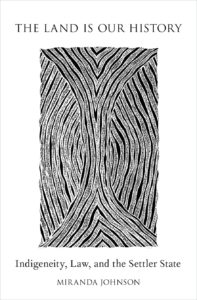The Land Is Our History author Miranda Johnson was awarded the Australian Historical Association’s W K Hancock Prize, which recognises an Australian scholar who has published a first book in any field of history in 2014 or 2015. To coincide with NAIDOC Week, here is an excerpt:
The late 1960s was a watershed moment for politics from below. Students protested immoral wars, civil rights activists urged the end of racial segregation, and anti-colonial revolutionaries called for the overthrow of imperial rule. New social and political movements forced their demands onto national and international agendas. Inspired by those movements, minority indigenous peoples in Australia, Canada, and New Zealand made distinct and unexpectedly powerful claims about their rights and the justice owed to them. Going beyond demands for civil rights, indigenous activists issued radical challenges to the settler states that surrounded them by pointing out that they were the prior occupiers and first peoples of the land. They insisted on their sovereignty and demanded recognition of their land and historical treaty rights. By pressuring governments and wider public to respond to their claims, which were ultimately concerned with the ongoing survival of their communities, indigenous peoples changed both their own status and the founding story of their settler state.
These three Commonwealth countries were the product of nineteenth-century colonization when white settlers, mainly from the British Isles, flooded into the Americas, southern Africa, and the Pacific. Intending to create new, more egalitarian, societies on what they saw as vacant or under-utilized lands, they dispossessed the original inhabitants through wars and sporadic frontier violence and by the use of specially designed legal instruments for the seizure of land. Decimated by introduced diseases and other consequences of dispossession, surviving indigenous peoples were pushed to the edges of colonial territories. By the end of the century, settler states, “uniquely destructive of indigenous rights,” had usurped the original inhabitants on lands they now called theirs. In Australia, Canada, and New Zealand, settler societies began to define their own sense of nationhood as they achieved self-government and political independence from Britain. At the same time, these three “Neo-Europes” in particular retained strong cultural, economic, and legal ties to Britain well into the twentieth century. Notably, these settler states, politically independent from the metropole but culturally and economically dependent on Britain, were constructed in terms that excluded the recognition of surviving indigenous nations.
Despite dispossession, marginalization and neglect, indigenous populations in fact began to increase again in the twentieth century. National governments considered new ways of incorporating these young and growing populations into the domestic workforce. Following World War II, governments in Australia, Canada, and New Zealand outlined what they saw as progressive policies of assimilation by which they envisaged indigenous peoples becoming full citizens who aspired to the same things that other settlers did. In this rendering, there was only one nation in the settler state, and it was, in cultural terms, a white settler nation. In the late 1960s, indigenous activists rejected progressive policies of assimilation as yet another example of colonization. They argued that their people had maintained their own collective identities as distinct nations within the settler state, and these nations were now under threat from assimilation. Thus, they broke apart the assumption of white policymakers that the nation-state was a single unity, arguing instead that the settler state was comprised of many nations.
In a dire context of new threats to indigenous lands as mining and development projects expanded to the remote regions of the three countries in the late 1960s, indigenous leaders urgently demanded that the settler state recognize their peoples’ land rights. These, they believed, would help them protect their collective identities. Faced with the intransigence of settler governments to recognize these rights, in the 1970s, young activists and older leaders brought claims for land and treaty rights to the courts and commissions of inquiry of the settler state. These were institutions that had been hostile to such claims in the past. For the first time, the histories and traditions relating to the lands and identities of indigenous peoples were taken into account by legal institutions.
The Land Is Our History explores how established leaders and young activists engaged legal strategies and what the larger outcomes of claims were for them and particularly for the settler states to which they appealed. Excavating connections between legal cases on new mining and development frontiers of Australia, Canada, and New Zealand from the early 1970s through to the mid-1990s, this book shows how activists – in concert with white judges, lawyers, and others – fashioned a new definition of indigeneity in the context of legal struggles. This emphasized that indigenous peoples’ identities were inextricably bound to the land. Importantly, this definition of indigeneity could be translated into a set of distinct rights at the level of the state. It also offered local communities new ways of imagining themselves as culturally unique and as having a kind of sovereignty within their own territories, and sharing certain predicaments with other indigenous peoples in other locales. Indigeneity thus allowed for multiple kinds of engagement including with other indigenous peoples across vast terrains and markedly different cultures, and also with settler states forced to reckon with indigenous demands. Eventually, the transnational circulation of indigeneity gained traction at the level of international law.


Leave a Reply